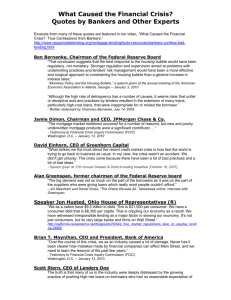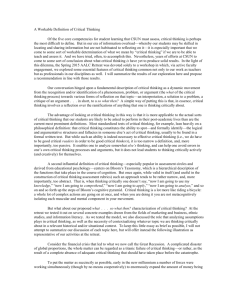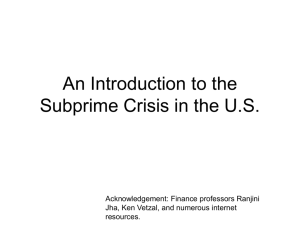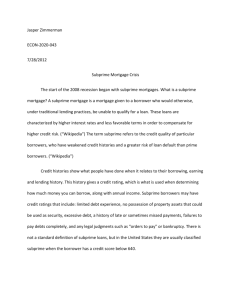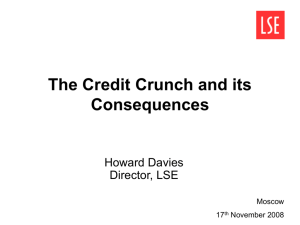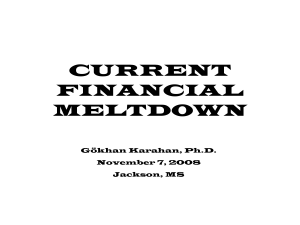Credit Crisis
advertisement
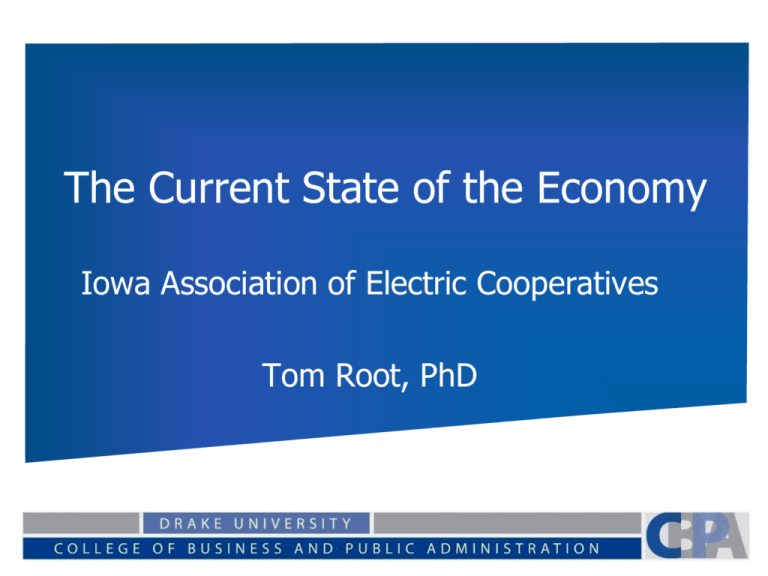
The Current State of the Economy Iowa Association of Electric Cooperatives Tom Root, PhD The Big Picture Problems in Mortgage Market Global Credit Crisis / Bank failures / Equity Losses Declining Consumer Spending Decreased Business Investment Whose to Blame? Economic Environment Congress Consumers Mortgage Originators Regulators Wall Street GSEs Rating Agencies Contributing Factors Consumer Debt and “Keeping up with the Joneses” International Capital Flows Congressional Unintended Consequences The Housing Market and “The American Dream” Regulatory Changes The Big Picture Problems in Mortgage Market Global Credit Crisis / Bank failures / Equity Losses Declining Consumer Spending Decreased Business Investment Mortgage Market Developments New Participants Increased Credit Access and New Loan Types Subprime Alt A “Teaser Rates” Option ARMs Securitization Securitization Loan Bank A Loan Bank B Loan Bank Z Financial Intermediary Buys Loans, Forms a “Pool” and Issues MBS Insurance Firm, Banks, Pension Funds etc. Buy MBS – Cash Flows “Guaranteed” by Original Mortgages 2000 - 2003 Fannie Mae announces it will buy $2 Trillion of loans from low income, minority and risky borrowers by 2010*. Subprime Loans = 3% of mortgage markets Target for the Federal Funds Rate 6.5% May 16, 2000 1.75% Dec 11, 2001 1% June 25, 2003 *NY Time Oct 4 2008 "Pressured to Take More Risk, Fannie Mae Hit a Tipping Point Federal Funds Rate Interbank lending – very short term – provides liquidity Market determines the actual rate Target set by Federal Reserve Board “Base Rate” The Basics of Banking Borrowing Short-Term and Lending Long-Term Deposit $1,000 Bank pays 1% or $10 to depositor Home Equity Loan $1,000 Bank charges 5% or $50 to borrower Bank “profit” = $40 Reserves The bank must keep a portion of deposits in reserve Withdraws Transactions “Lending Reserves” and Federal Funds Market Bank Balance Sheet Assets Use of funds to generate income Liabilities and Equity Source of funds Liabilities (borrowing) Equity (ownership stake) Bank Balance Sheet Assets (Income) Loans Cash Treasury Securities Mort. Back Securities Corporate Bonds Stocks Liabilities (costs) Deposits S-T Borrowing L-T Borrowing Equity (ownership) Monetary Policy Federal Reserve Board “Lender of Last Resort” Managing Cash available for lending More cash available lowers interest rates Less cash available increases interest rates (rates impact borrowing / spending and growth) Monetary Policy Tools Reserve Requirements Discount Window Lending Open Market Operations Buying and selling Treasury Securities Replacing illiquid assets with cash and vice versa Impact of Low Rates 2001-2004 Strong economic growth without inflation Housing boom pushed housing prices up New loan standards Speculation on home prices by “average consumers” Increased availability of international funds Strong demand for MBS Congressional pressure to increase lending to under served markets Missed Opportunities 2003 Accounting Scandals at GSEs W. Poole, Pres. Fed Reserve Bank of St Louis* “If the market value of GSE debt were to fall sharply, because of ambiguity about the financial soundness of GSEs and about the willingness of the federal government to backstop the debt, what would happen? I do not know, and neither does anyone else.” Dec 2003 Fed Reserve releases study showing GSEs have not lowered lending rates.** February 2004 – Alan Greenspan calls for reform & removal of the implicit government guarantee*** *"Housing and the Macroeconomy" Speech at Office of Federal Housing Enterprise Oversight Symposium http://www.stls.frb.org/news/speeches/2003/3/10/03.html **Christmas for Fannie, WSJ 9/9/08 ***"Fran and Fred Get The Business WSJ 2003 3/10/03 2004 Market Developments SEC lowers capital requirement rules for largest financial firms.* Deterioration of underwriting standards.** August - Moody’s and S&P change rating standards for MBS, incorrectly rate many MBS AAA*** 2004 HUD increases Fannie and Freddie mandate from 50% “affordable housing” to 56%**** Target for Fed Funds starts to increase June 30, 2004 1.25%, December 13, 2004 2.25% * NY Times Oct 3, 2008 Agency's '04 Rule Let Bank Pile Up New Debt **President's Working on Financial Markets, US Treasury Dept March 2008 ***Smith, Elliot, "Race to the Bottom at Moody's, S&P Secured Subprime's Boom and Bust" Bloomberg.com, Sept 2008 **** How HUD Mortgage Policy Fed the Crisis, Washington Post, June 10, 2008 Fannie Mae’s Guarantee of Alt A Loans $ Billions of Alt A Loans Guaranteed 300 2007 $79 Billion Added 250 2006 $87 Billion Added 200 150 2005 $58 Billion Added 100 50 2004 & Before $77 Billion Total 0 NY Times October 4 "Pressured to Take More Risk Fannie Hit a Tipping Point" Blaming Fannie and Freddie? No - Fannie and Freddie were small relative to the entire market. Combined Subprime Purchases (% of Market)** Consumer demand created rapid prince increase Yes – Overall Size put them at risk for any mortgage market problem Securitizing more risky loans opened door for private securitization Gramlich, E. "Subprime Loans: America's Latest Boom an Bust" 2007 ** "how HUD Mortgage Policy Fed the Crisis", Washington Post June 10, 2008 Impact of Subprime Loans on Home Ownership "SubPrime Lending: A Net Drain on Homeownership," Center for Responsible Lending: March 2007 “The Perfect Storm” 2004 - 2007 Domestic and global institutions buy MBS in attempt to increase margins on “safe” securities, incorrectly rated. Institutions use higher debt levels for securitization. Underwriting standards deteriorate. Increased interest rate environment makes loans more likely to default Increasing Home Prices encourage consumers to overextend and speculate in housing market Average Size of Subprime Loan Demyanyk and Van Hermert, "Understanding the Subprime Mortgage Crisis" Federal Reserve Bank of St. Louis, Working paper 200705, August 2008 (sample represents approximately 85% of securitized subprime loans, over 50% to total subprime Credit Quality of Subprime Loans Originated each year Demyanyk and Van Hermert, "Understanding the Subprime Mortgage Crisis" Federal Reserve Bank of St. Louis, Working paper 2007-05, August 2008 (sample represents approximately 85% of securitized subprime loans, over 50% to total subprime Structure of Subprime Loans Originated each year Demyanyk and Van Hermert, "Understanding the Subprime Mortgage Crisis" Federal Reserve Bank of St. Louis, Working paper 2007-05, August 2008 (sample represents approximately 85% of securitized subprime loans, over 50% to total subprime Home Sales and Home Prices Non Agency Mortgage Foreclosure Rates The Big Picture Problems in Mortgage Market Global Credit Crisis / Bank failures / Equity Losses Declining Consumer Spending Decreased Business Investment Impact on Financial Institutions Foreclosures cause value of MBS securities to decrease raising concerns about stability of banks and financial institutions Banks start to keep cash Protect against withdraws Uncertainty about borrowers ability to repay Interest rates start to increase 2007 Market News Consumer Confidence starts to decline in July 2007 (Conference Board) Late 2007 over 20% of all adjustable rate subprime loans and 8% of fixed rate subprime loans are delinquent Dec 12 – Fed Reserve announces Term Auction Facility allowing depository institutions to bid for short term (28 to 84 day) loans August / September 2008 Financial Markets Global concerns increase, European banks have liquidity concerns Measures of confidence decrease and credit spreads increase Banks keep cash in fear of runs on liquidity and make fewer loans Cost of short term borrowing increases for business Bank Balance Sheet Assets (income) Loans Cash Treasury Securities Mort. Back Securities Corporate Bonds Stocks Liabilities (costs) Deposits S-T Borrowing L-T Borrowing Equity (ownership) 2008 Financial Institution Failures January – Bank of America buys Countrywide March - Bear Stearns is bought by JP Morgan in deal brokered by Fed, approved 5/29/08 7/12/08 IndyMac Bank Fails 9/8/08 Fannie and Freddie are taken over by government 9/14/2008 Lehman Bros is allowed to fail & Merrill Lynch is bought by Bank of America 9/17/08 AIG is bailed out by government 9/21/08 Goldman Sachs and Morgan Stanley become commercial banks as opposed to investment banks 10/3/08 Wachovia is bought by Wells Fargo after backing out of deal with Citigroup Lehman Brothers Largest Issuer of Commercial Paper Large player in Fixed Income Active in Credit Default Swaps The Big Picture Problems in Mortgage Market Global Credit Crisis / Bank failures / Equity Losses Declining Consumer Spending Decreased Business Investment Spillover Failure of Financial Institutions Uncertainty about value of assets Fear of Liquidity (Runs on banks) Loss of Lehman – Commercial paper and CDS Consumer Confidence shaken Retirement account uncertainty Sale of assets Decreasing share price Decrease asset values Supplemental Federal Reserve Actions December 12, 2007: Term Auction Facility (TAF) December 12, 2007: New FX swap lines with the ECB and SNB announced. March 11, 2008. Term Securities Lending Facility March 16, 2008. Primary Credit Dealer Facility September 14, 2008. TSLF expanded to $200 billion September 24, 2008. FX swap lines to $277B September 29, 2008 Federal Reserve coordinate with other central banks to expand significantly the capacity to provide U.S. dollar liquidity Supplemental Federal Reserve Actions - Oct October 6, 2008 Board announces that it will begin to pay interest on depository institutions' required and excess reserve balances October 7, 2008 Board announces creation of the Commercial Paper Funding Facility (CPFF) to help provide liquidity to term funding markets October 21, 2008 Federal Reserve announces the creation of the Money Market Investor Funding Facility (MMIFF) Nov 10, 2008 American Express becomes bank holding company Assets on Fed Res Balance Sheet Aug 2008 – April 2009
